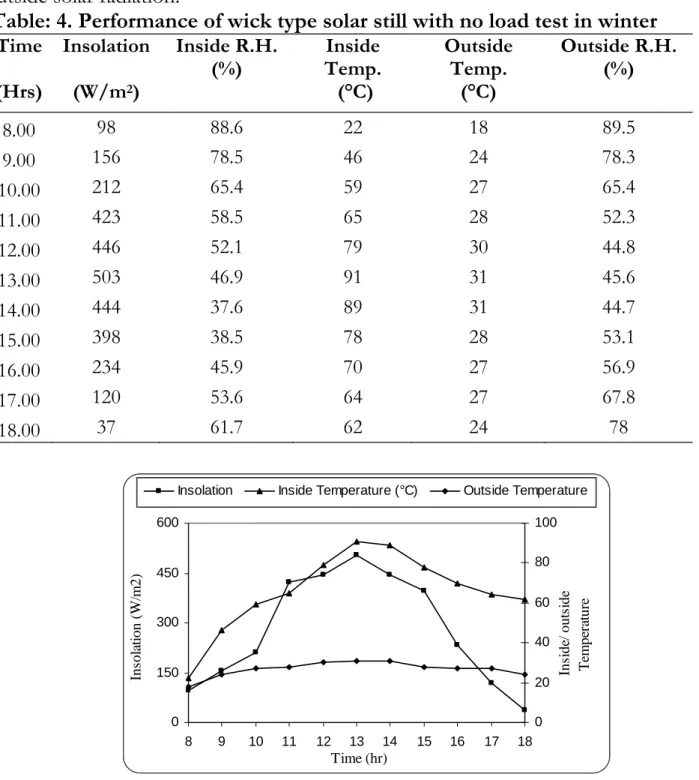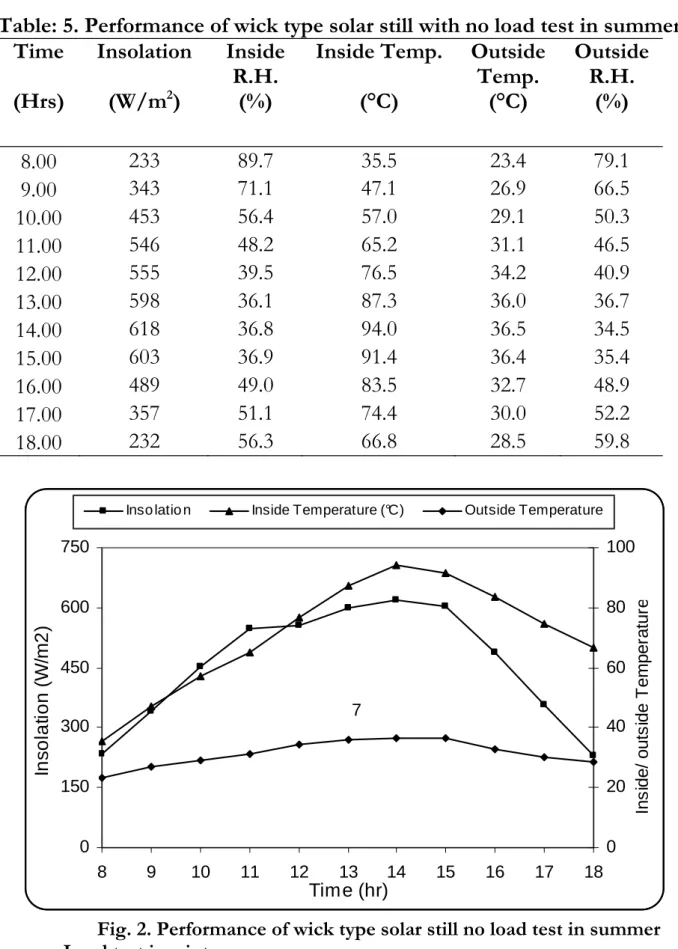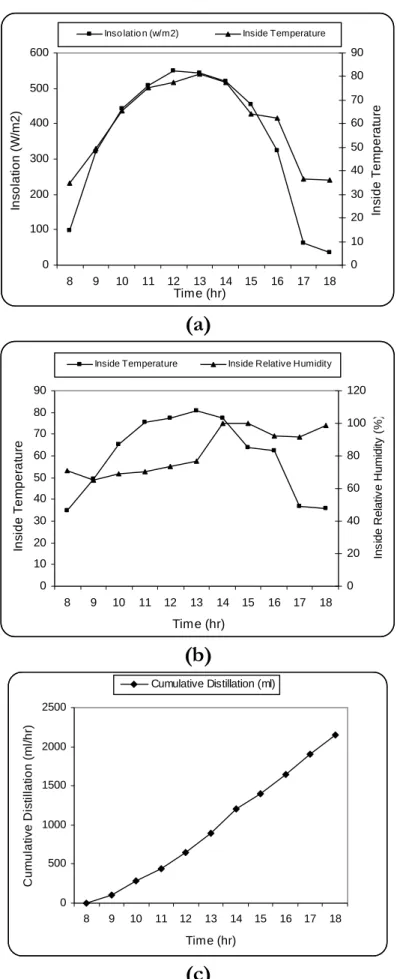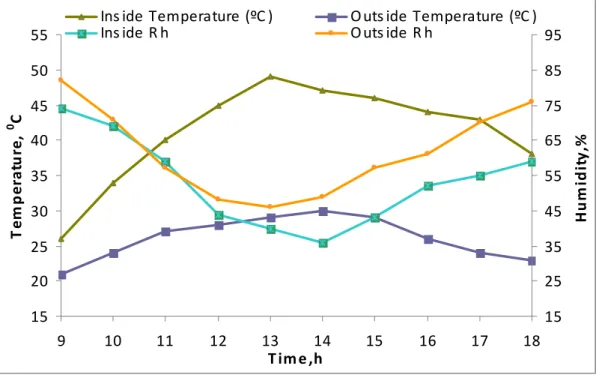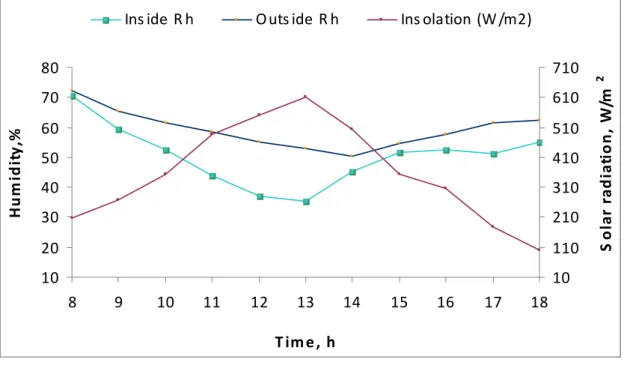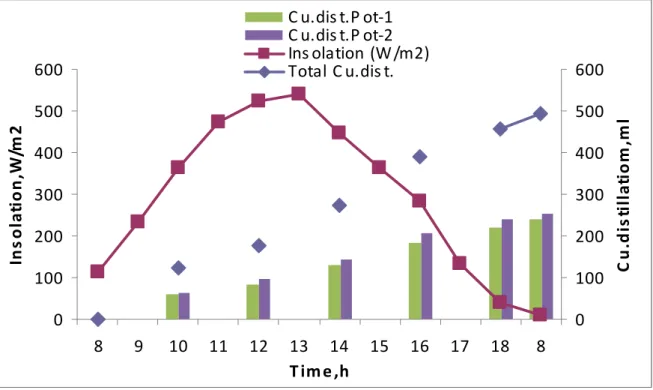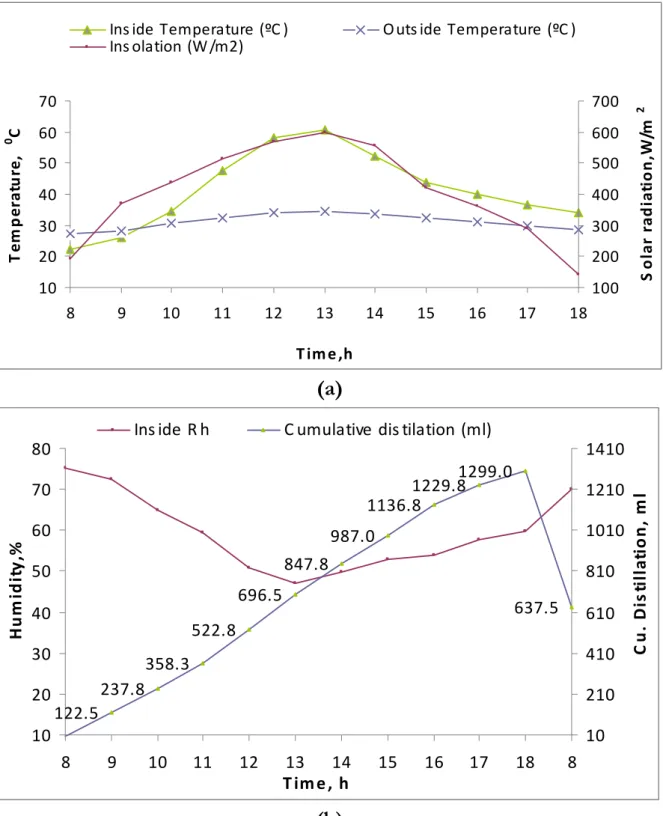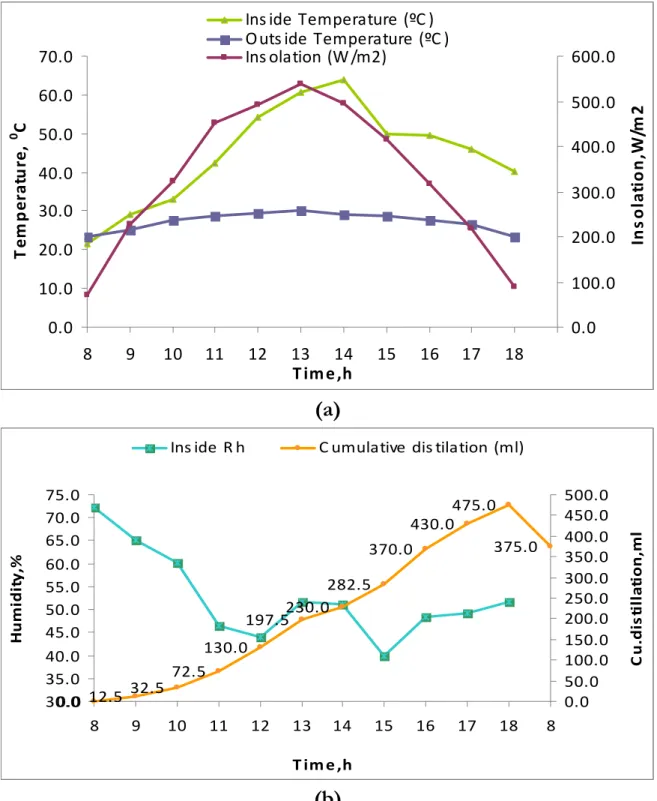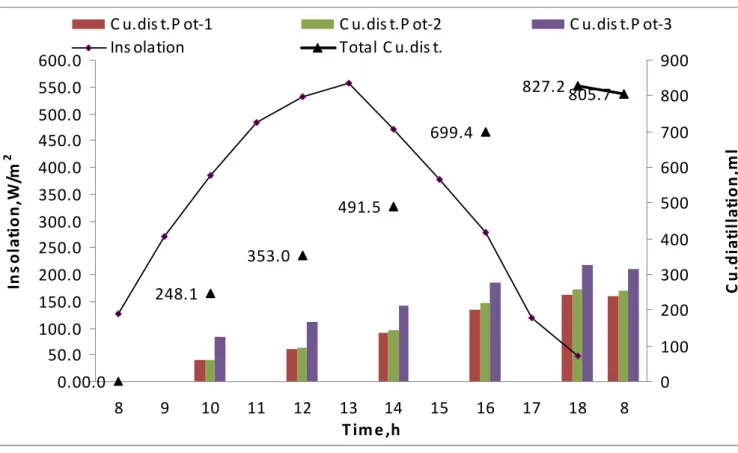New Innovation of low cost solar still
1
S H Sengar,
1Y P Khandetod,
1A G Mohod
Abstract
Different solar stills were developed and evaluated for comparison with other solar stills available in market. Comparatively more distilled water was obtained from the solar still having an area of 1m2 fabricated in fiber or metal body with glass glazing like single slope ,double slope and wick type solar still. Average maximum temperature and humidity was more in double slope, single slope and wick type solar still and hence the average quantity of distilled water obtained as 1350 ml/day, 1550 ml/day and 2450 ml/day respectively. The plastic made up of W-shape solar still provided with 3 channels produce maximum distilled water as 2104 ml/day where as W- shape solar still with two channels erected on concrete and ground produced only 1012ml/day and 1443 ml/day respectively. L shape solar still produce average distilled water was 925 ml/day which was very low among the all type of solar still. Comparative cost of compact nature of solar stills like single slope, double slope and wick type solar still was more than Rs.7000/- which is four times more than newly developed W-shape 3 channel solar still. Comparative output from newly developed solar still was low but it has several advantages that it is cheapest, cost efficient and easy to clean. Concentration of pH, EC, TDS and ions in solar distilled water was found to be similar as conventional distilled water. The cost of W shape three channel solar still is recovered within 4 months 6 days only.
Keywords
: solar stills, chemical analysis, economicsMethodology
Wick type, W shape and L shape of solar stills were designed on the basis of solar declination angle, slope of collector and available insolation. During theoretical design calculations of solar still (Plate 1), peak winter season was considered. In winter season, December month was selected for finding the solar declination angle (δ), Slope of collector (β), intensity of insolation on horizontal and vertical surface and value of Cos θ is shown in Table 1. The newly developed solar stills were evaluated for load test and compared with the output of single and double slope solar still available in market.
Table: 1. Details of design calculations for even type solar still.
S.
N. Particulars Symbol Design parameter of solar still 1 Solar declination angle δ δ = 23.45 sin [0.9863(284 + n)]
δ = - 23.3 2 Slope of collector β β = (Φ - δ)
β = 40º 48’
3 Intensity of insolation on
horizontal Ic Ic = Ih × Cos θ Ic = 450 W/m2 4 Intensity of insolation on
sloping surface Is Is= Ih × Cos θ/ Cos θh Is = 594.5 W/m2
5 Cosine of θh θh θh= 40º.8’
Wick Type Solar still
Wick Type Solar still was fabricated at the central workshop of the College of agricultural Engineering and Technology, Dapoli. The pictorials view with different component of wick type solar still is shown in Plate1.
The device was consisted of a base frame made up of angle irons of size 25mm x 25 mm x 4mm, which was 1m x 1m in size and formed the rigid base for the complete unit.
The main frame was also made up of angle irons of size 25mm x 25 mm x 3 mm, rested on the base frame and hinged from one side for the angle adjustment. The frame was enclosed with the 18 gauge and 24 gauge GI sheets and a thermacol was placed in between the two sheets as insulation from all sides
except from top. The absorber consisted of a corrugated sheet of 24 gauge and of 1m2 area for increasing absorption of incident solar radiations. The unit was painted with blackboard paint for attaining higher absorption of incident solar radiations. The unit was covered with a glass cover of 5mm thick plane glass, fitted in aluminum frame having an area of 1m2. The greenhouse effect was possible due to glass which entrapped long wave radiations. The collected water vapour got condensed on inner side of glass.
Device was basically divided into three components as heating chamber, cooling cover and collection unit. Inside the heating chamber, GI pipe was provided for continuous water supply with 15 pin holes of 3 mm drill. The pipe was connected to a storage tank for continuous water supply.
The jute was used as a wick material, which was laid on the corrugated absorber plate with sufficient open area for exposing the black ridge of corrugated absorber. The wick material absorbed the droplets of water coming out from GI pipe and carried this water along the length of the material by capillary action. During this process unused water was collected through the drain outlet and distilled water was collected separately from opposite side and collected in beaker.
The water which was evaporated at higher temperature inside the heating chamber got condensed on the glass surface. The channel was provided for its collection. Water vapour inside the heating chamber got condensed in small droplets of liquid due to low temperature of glass cover. The total cost of this solar still was Rs.7241/- shown in Table 2.
Low cost (W-shape) solar still
Low cost (W-shape) solar still frame was design and fabricated at the central workshop of the College of Agricultural Engineering and Technology (CAET), Dapoli. This still was fabricated using 25 mm diameter M.S. pipe to make the frame as shown in Plate 2. The pipes and corners were well polished and
laminated in order to avoid corrosions as well as to protect the polythene sheet from damage. The size of basin was 2 m x 2 m was prepared with black plastic covered basin in soil (Plate-2), in which water was impounded. The UV
stabilized 200 micron polythene sheet of size 4 x 2.5 m was wrapped properly over the frame so that it became leak proof. The distilled water-collecting channel made from GI sheet wrapped with plastic was attached below to the frame with the help of non-corrosive wires.
Table: 2. Materials used in wick type solar still Sr.N
o. Item Specifications Weight
(kg) Rate
(Rs.) Cost (Rs.) 1 M.S. Angle 25mm x 25mm x 4mm
3/16 9 60 540/-
2 M.S. Angle 25mm x 25mm x 3mm 12 60 720/-
3 GI Sheet 18 gauge 21 75 1575/-
4 GI sheet 24 gauge 2 75 150/-
5 Corrugated sheet 24 gauge 2 150 400/- 6 M.S. Flat 25mm x 4mm 3.5 45 158/-
7 GI pipe 63 mm diameter 2 m 200/m 400/- 8 M.S. rod 5 mm diameter 4 45 180/-
9 Bucket plastic pipe 100/-
10 Thermocol 25mm thick 30/She
et 120/- 11 Hinges (2) 25mm x 25mm 30/Pie
ce 60/-
12 Lambi 100 gm 50/-
13 Red oxide 100 gm 30/-
14 Blackboard paint 500 ml 50/-
15 Gromate 5/Piec
e 10/-
16 Cock (Plastic) 5/Piec
e 5/-
17 Araldite (2) 30/Pie
ce 60/- 18 Glass with frame 1 m x 1 m 942/-
19 Nut and Bolts (10) 20/-
20 Labour Charges 30% 1671
Total 7241/-
The collecting channels were fabricated so as to catch the condensed droplets of water inside the solar still. The material used for the fabrication of this unit is presented in Table 3. This (W-shape) solar still frame along with UV stabilized plastic as glazing kept over the basin dug on ground (Plate 2) and making it leak
proof by using soil cover. The water present in basin got evaporated due to higher temperature inside the heating chamber. Water vapour inside the heating chamber got condensed in the form of small droplets of water due to lower temperature on inner side of polythene. Condensed droplets of evaporated water were collected through three channels. Surrounding condensed water was collected through third channel from all sides at bottom (Plate 3). First two channels which fixed inside solar still (Plate 4)
Plate: 4. Two channel provision for W-shape solar still Plate-3 Third channel Third channel
W shape two channels solar still was also erected over the cement block (Plate 5) for performance of distilled water. The cost required to erect w shape solar still on ground and cement were Rs. 1848/- and 4000/-
(a)
Plate: 5. W-shape solar still on concrete with two channel Low cost (L-shape) solar still
By using wooden strips and aluminum channel L shape solar still was developed with plastic glazing on soil for distilled water output through single channel. The size of L shape solar still was 2 m2 (1.4m x1.4m). The total cost required to erect L shape solar still on ground was Rs.1000/-
Table: 3. Material used for fabrication of Solar Distillation unit Sr.
No. Item Specification Quantity
required Rate of
item Total Cost (Rs.) 1 M. S. pipe(Low grade) 25 mm
diameter 15.8 m 40/m 732/-
2 Polythene film 4 x 2.5 m 50/m2 500/- 3 GI sheet 18 gauge 0.3 x 2.2 m 220/m2 150/- 4 Red paint 100 gm 600/kg 60/-
5 Black paint 500 gm 240/kg 120/- 6 Cement 53 grade 5 kg 10/kg 50/-
7 Sand Fine 10 kg 40/-
8 Welding rod Short length 8 rods 12/rod 96/- 9 Labor charge 2 days Rs.100/day 200
TOTAL 1848/- Results and Discussions
Performance Evaluation
Developed solar stills were evaluated for winter and summer months with load test at 40° angle. Devices were tested for comparison with the output of distilled water from single and double slope still units available in market.
Wick type No load test
Wick type solar still having area 1m2 (1m x 1m) is evaluated for no load test in winter. Maximum temperature was obtained at 1P.M.in solar still, where solar intensity was 503 W/m2, inside temperature was 91○C, ambient temperature was 31○C and outside relative humidity was 45.6 per cent. The trend obtained in no load test during performance of bare still unit is shown in Table 4. It was observed from Fig 1 that as inside temperature increased, inside relative humidity decreased and vice versa. It was also observed that the temperature inside the solar still increased with outside solar radiation. In no load test in summer, maximum temperature was obtained at 2 P.M., where solar intensity was 618 W/m2, inside temperature was 94°C, ambient temperature was 36.5°C and
outside relative humidity was 34.5%. The trend obtained in no load test during performance of bare solar still is shown in Table 5. It was observed (Fig 2) that as inside temperature increased, inside relative humidity decreased and vice versa.
It was also observed that the temperature inside the solar still increased with outside solar radiation.
Table: 4. Performance of wick type solar still with no load test in winter Time
(Hrs)
Insolation (W/m2)
Inside R.H.
(%) Inside Temp.
(°C)
Outside Temp.
(°C)
Outside R.H.
(%)
8.00 98 88.6 22 18 89.5
9.00 156 78.5 46 24 78.3
10.00 212 65.4 59 27 65.4
11.00 423 58.5 65 28 52.3
12.00 446 52.1 79 30 44.8
13.00 503 46.9 91 31 45.6
14.00 444 37.6 89 31 44.7
15.00 398 38.5 78 28 53.1
16.00 234 45.9 70 27 56.9
17.00 120 53.6 64 27 67.8
18.00 37 61.7 62 24 78
0 150 300 450 600
8 9 10 11 12 13 14 15 16 17 18
Time (hr)
Insolation (W/m2)
0 20 40 60 80 100
Inside/ outside Temperature Insolation Inside Temperature (°C) Outside Temperature
Fig. 1. Performance of wick type solar still no load test in winter
Table: 5. Performance of wick type solar still with no load test in summer Time
(Hrs)
Insolation
(W/m2)
Inside R.H.
(%)
Inside Temp.
(°C)
Outside Temp.
(°C)
Outside R.H.
(%)
8.00 233 89.7 35.5 23.4 79.1
9.00 343 71.1 47.1 26.9 66.5
10.00 453 56.4 57.0 29.1 50.3
11.00 546 48.2 65.2 31.1 46.5
12.00 555 39.5 76.5 34.2 40.9
13.00 598 36.1 87.3 36.0 36.7
14.00 618 36.8 94.0 36.5 34.5
15.00 603 36.9 91.4 36.4 35.4
16.00 489 49.0 83.5 32.7 48.9
17.00 357 51.1 74.4 30.0 52.2
18.00 232 56.3 66.8 28.5 59.8
0 150 300 450 600 750
8 9 10 11 12 13 14 15 16 17 18
Time (hr)
Insolation (W/m2)
0 20 40 60 80 100
Inside/ outside Temperature
Inso latio n Inside Temperature (°C) Outside Temperature
7
Fig. 2. Performance of wick type solar still no load test in summer Load test in winter
At 40° angle of collector, maximum temperature obtained at 1 P.M was 81.0°C, where solar intensity was 544 W/m2 and ambient temperature was
32°C as shown in Table 6. It was also observed that the maximum wind speed was 7.6 m/s at 1P.M. and hence during that period the maximum distillation rate i.e. 300 ml/hour was observed.
Table: 6. Performance of wick type solar still in winter Time
(Hrs)
Insola
tion Inside R.H.
(%)
Inside Temperat
ure (°C)
Outside Temperatu
re (°C)
Outsid e R.H.
(%)
Win d spee
d
Cumulativ e Distillatio
n (ml)
8.00 98 71 34.8 21.3 88.5 0 0
9.00 320 65.4 49.3 26.8 81.3 0 100 10.00 443 69 65.3 27.3 67 2.1 290 11.00 508 70.1 75.4 28.9 56.5 5.3 440 12.00 550 73.4 77.6 31.6 44.1 6.9 650 13.00 544 76.8 81 32 35.4 7.6 900 14.00 520 100 77.4 33.5 37 2.9 1200 15.00 453 100 64.1 35.1 38.5 2.5 1400 16.00 323 92 62.3 36.8 46.9 2.5 1650 17.00 61 91.6 36.7 30 58.6 0.5 1900 18.00 36 98.4 35.9 28.4 72.4 0.2 2150
Overnight distillation up to 8.00 a.m. 150
Total 2300 The trend obtained during performance showed in the Fig. 3 as in the
beginning solar intensity increased, inside R.H. and temperature increased and once the R.H. attained 100% value, it remain unchanged invariant of solar intensity. Cumulative distilled water obtained from wick type solar still at 40º in winter was 2300 ml as shown in Table 6.
0 100 200 300 400 500 600
8 9 10 11 12 13 14 15 16 17 18 Time (hr)
Insolation (W/m2)
0 10 20 30 40 50 60 70 80 90
Inside Temperature
Inso latio n (w/m2) Inside Temperature
(a)
0 10 20 30 40 50 60 70 80 90
8 9 10 11 12 13 14 15 16 17 18 Time (hr)
Inside Temperature
0 20 40 60 80 100 120
Inside Relative Humidity (%)
Inside Temperature Inside Relative Humidity
(b)
0 500 1000 1500 2000 2500
8 9 10 11 12 13 14 15 16 17 18 Time (hr)
Cumulative Distillation (ml/hr)
Cumulative Distillation (ml)
(c)
Fig. 3. Performance of wick type solar still with load in winter
Load test in summer
During the performance of wick type solar still with wick material at 40°
angle of collector during summer, maximum temperature obtained at 1 P.M was 86.2°C, when solar intensity was 600 W/m2 and ambient temperature was 38.0°C. The trend obtained as shown in Fig. 4 shows that distilled water obtained was minimum compared to winter. Maximum cumulative distilled water obtained was 2550 ml/day.
Table: 7. Performance of wick type solar still in summer
Time Insolation (W/m2)
Inside R.H.
(%)
Inside Temp.
(°C)
Outside Temp.
(°C)
Outsid e R.H.
(%)
Wind speed (m/s
)
Cumulative Distillation
(ml)
8.00 234 72.3 45.2 27.1 72.1 0 0
9.00 455 78.5 59.1 29.4 56.2 0.3 100
10.00 549 76.4 76.4 30.8 41.1 5.1 300
11.00 607 71.1 79.9 34.2 34.5 0.5 550
12.00 617 69.4 81.5 36.7 32.1 2.2 800
13.00 600 71.6 86.2 38 33.5 1.2 1000
14.00 601 75.3 82.4 37.3 38.6 0.1 1250
15.00 553 78.1 74.6 34.2 42.9 0 1500
16.00 421 83.8 70.4 31.3 50.1 4.3 1800
17.00 267 88.5 62.5 30.5 57 2.5 2100
18.00 165 89 57.1 30.1 69.3 1.6 2350
Overnight distillation up to 8.00 a.m. 200
Total 2550
0 150 300 450 600 750
8 9 10 11 12 13 14 15 16 17 18 Time (hr)
Insolation (W/m2)
0 10 20 30 40 50 60 70 80 90 100
Inside Temperature
Inso latio n (w/m2) Inside Temperature
(a)
0 10 20 30 40 50 60 70 80 90 100
8 9 10 11 12 13 14 15 16 17 18 Time (hr)
Inside Temperature
0 20 40 60 80 100 120
Inside Relative Humidity (%) Inside Temperature Inside Relative Humidity
(b)
0 500 1000 1500 2000 2500
8 9 10 11 12 13 14 15 16 17 18 Time (hr)
Cumulative Distillation (ml)
Cumulative Distillation (ml)
(c)
Fig. 4. Performance of wick type solar still with load in summer Selection of poly film materials
Before using poly film as glazing material, it checked for its maximum transmitivity of solar radiation. Transitivity of polyfilm was checked out by using solarimter readings in W/m2. The three type of polyfilm like plain polyfilm (silpolin), polyfilm antisulphur and UV stabilized polyfilm were selected for better transmitivity. The inside and outside solar radiations at same height were observed in clear sky condition for all selected polyfilm. It was observed that 76.83 % solar radiation were transmitted from UV stabilized 200 micron white polyfilm where as 65.73 % transmitivity observed in polyfim antisulphur and 69.97 % in plain polyfil (silpolin) shown in Fig.5 ( a) and (b).
100 200 300 400 500 600 700 800
8 9 10 11 12 13 14 15 16 17 Time (hrs)
Inside radiation (W/m2 )
Polyfilm Polyfilm Antisulphur Polyfilm UV stabilized
Fig.5. (a) Transmitivity of solar radiation inside poly film.
45 55 65 75 85 95
8 9 10 11 12 13 14 15 16 17 Time (hrs)
Transmitivity (%)
Polyfilm Polyfilm Antisulphur Polyfilm UV stabilized
Fig.5. (b) Transmitivity of solar radiation inside poly film.
W -shape solar still on concrete two channels No load test
The low cost W-shape solar still with area of 2 m2 (2m x 1m) was evaluated for no load test. The maximum average temperature was observed
during no load test was 49 ºC at 1 p.m. and the same time solar intensity was 553 W/m2, ambient temperature was 29 ºC, and outside relative humidity was 46 per cent. The trend obtained in no load test during performance testing is as shown in Fig 6 and Table 8. It is revealed from Fig 6 that the temperature inside the still increased with solar intensity in morning hours up to 1 P.M., and then started decline as day progressed.
Table: 8. Performance of W-shape solar still on concrete two channel with no load test in winter
Time
(Hrs)
Insolation
(W/m2)
Inside Temp.
(ºC)
Ambient Temp.
(ºC)
Inside Humidity
(%)
Outside Humidity
(%)
9.00 152 26 21 74 82
10.00 301 34 24 69 71
11.00 454 40 27 59 57
12.00 521 45 28 44 48
13.00 553 49 29 40 46
14.00 502 47 30 36 49
15.00 415 46 29 43 57
16.00 287 44 26 52 61
17.00 163 43 24 55 70
18.00 63 38 23 59 76
20 30 40 50 60 70 80 90
9 10 11 12 13 14 15 16 17 18
T im e ,h
Humidity,%
60 160 260 360 460 560 660
Insolation, W/m2
Ins ide Temperature (ºC ) O uts ide R h Ins olation (W /m2)
(a)
15 20 25 30 35 40 45 50 55
9 10 11 12 13 14 15 16 17 18
T im e ,h Temperature,0 C
15 25 35 45 55 65 75 85 95
Humidity,%
Ins ide Temperature (ºC ) O uts ide Temperature (ºC )
Ins ide R h O uts ide R h
(b)
Fig. 6. Performance of W-shape solar still on concrete two channels with no load test in winter
Load test
W-shape solar still with two channels was tested with impounding water depth in cement basin. The hourly cumulative distilled water obtained was observed with solar intensity, ambient temperature, relative humidity and inside temperature. shown in Table 9 and Fig 7.
It was observed from Table 9 that maximum average temperature was observed at 1 p.m., when solar intensity was 523 W/m2 and ambient temperature was 31.9 ºC, ambient R.H. was 48 per cent. Trend observed in load test during performance is shown in Fig 6. It was observed that inside temperature increased as the solar intensity increased and hence rate heat utilization for heating the water was more in noon time and accordingly evaporation was observed more after noon hours and then rate of condensation was increased than noon time as solar intensity decreased. Cumulative distilled water obtained from solar still in summer month was 1274 ml including day and night condensation. It was observed that maximum distillation rate obtained between 3 pm to 4 pm which was highest as 138 ml. Average overnight distillation observed in even type solar still unit was 348 ml which was due to higher condensation rate in night.
Table: 9. Performance of W-shape solar still on concrete two channels during load test in summer
Time
(Hrs) Insolation
(W/m2) Inside Temperature
(ºC)
Outside Temperature
(ºC)
Outside R.H.
(%)
Cumulative
desalination
(ml)
8.00 103.3 23.3 25.7 75.3 0.0
9.00 159.3 24.5 26.8 68.5 86.3
10.00 317.5 33.8 28.2 65.6 145.0
11.00 376.8 43.8 28.7 61.6 230.8
12.00 480.8 49.0 30.0 57.6 327.3
13.00 523.1 53.8 31.4 52.1 429.5
14.00 499.0 55.8 31.6 50.4 537.3
15.00 413.3 50.8 30.6 54.8 652.0
16.00 336.3 45.3 29.5 59.9 790.8
17.00 228.3 41.1 28.8 63.8 862.0
18.00 150.5 36.3 28.0 67.4 925.0
Overnight distillation up to 8.00 a.m. 348.8
Total 1273.8
20.0 25.0 30.0 35.0 40.0 45.0 50.0 55.0 60.0
8 10 12 14 16 18
T im e ,h Temperatue,0 C
0.0 100.0 200.0 300.0 400.0 500.0 600.0
Insolation,W/m2
Ins ide Temperature (ºC ) O uts ide Temperature (ºC ) Ins olation (W /m2)
(a)
0.0
86.3145.0 230.8
327.3 429.5
537.3 652.0
790.8862.0925.0
348.8
40 140 240 340 440 540 640
8 9 10 11 12 13 14 15 16 17 18 8
T im e ,h
Humidity, %
0 100 200 300 400 500 600 700 800 900 1000
Cu.distillation,ml
Ins olation,W /m2 C umulative dis tilation (ml)
(b)
Fig. 7. Performance of W-shape solar still on concrete two channels during load test in summer
The maximum cumulative distillation obtained in summer season was 1273 ml, solar intensity played vital role in rate and quantity of distillation through the plant.
W- shape solar still on soil two channels No load
W-shape solar still with two channels was erected on ground and the collected distilled water with two channels was periodically observed along with solar energy, ambient temperature. Inside and outside humidity. The still was evaluated in summer for no load. In summer, maximum inside temperature reached in solar still was 45.1 oC where ambient temperature, solar radiation and relative humidity were found as 35.2,612 and35.2 respectively shown in Table 10 and Fig.8.
Table: 10. Performance of W-shape solar still on ground two channels during no load test in summer
Time
(Hrs) Insolation
(W/m2) Inside Temperature
(ºC)
Outside Temperature
(ºC)
Inside
Rh Outside Rh
8.00 208 28.2 26.6 70.5 72.1
9.00 268 33.1 29.9 59.2 65.4
10.00 355 35.8 31.5 52.4 61.5
11.00 487 45.4 33.6 43.8 58.7
12.00 549 47.2 34.5 37.2 55.2
13.00 612 45.1 35.2 35.2 52.9
14.00 502 46.8 33 45.4 50.4
15.00 355 44.4 32.2 51.7 54.6
16.00 306 44.2 30.2 52.6 57.8
17.00 177 43.4 31 51.4 61.4
18.00 102 42.1 28.5 55 62.5
10 15 20 25 30 35 40 45 50
8 9 10 11 12 13 14 15 16 17 18
T im e , h Temperature,0 C
10 110 210 310 410 510 610 710
Solar radiation, W/m2
Ins ide Temperature (ºC ) O uts ide Temperature (ºC ) Ins olation (W /m2)
(a)
10 20 30 40 50 60 70 80
8 9 10 11 12 13 14 15 16 17 18
T im e , h
Humidity,%
10 110 210 310 410 510 610 710
Solar radiation, W/m2
Ins ide R h O uts ide R h Ins olation (W /m2)
(b)
Fig. 8. Performance of W-shape solar still on ground two channels during
no load test in summer With Load
W shape solar still erected on ground with a provision of two channels for collections was evaluated for winter and summer depicted in Table 11 and Fig.9 and Table 12 and Fig.10 respectively. In winter maximum distilled water collected from 24 hour was only 950 ml which was very less comparing to distilled water obtained in summer as 1936.5 ml from same unit.
Table: 11. Performance of W-shape solar still on ground two channels during
load test in winter
Time h
Insolation (W/m2)
Inside Temp.
(ºC) Outside Temp.
(ºC)
Inside Rh (%)
Outside Rh (%)
Cu.dist .-pot-1 (ml)
Cu.dist.-
Pot-2(ml) Total Cu.dist.
(ml) 8.0 114.3 22.4 19.8 76.6 75.6 0.0 0.0 0.0 9.0 232.0 29.5 21.3 73.8 69.8
10.0 362.5 34.6 23.1 58.1 62.3 58.8 64.4 123.1 11.0 474.4 38.2 28.6 53.7 52.3
12.0 522.1 44.7 30.5 48.8 49.5 82.5 95.6 178.1 13.0 538.8 44.2 29.7 50.1 48.6
14.0 445.8 45.9 29.2 47.6 49.5 130.6 143.8 274.4 15.0 362.9 40.8 28.4 47.0 51.5
16.0 284.1 40.1 28.0 50.1 54.4 183.8 205.6 389.4 17.0 132.1 35.4 25.9 58.0 56.3
18.0 40.0 30.1 24.7 67.5 65.9 219.4 238.8 458.1
Overnight distillation up to 8.00 a.m. 239.2 252.8 491.9
Total 950
(a)
0 100 200 300 400 500 600
8 9 10 11 12 13 14 15 16 17 18 8
T im e ,h
Insolation,W/m2
0 100 200 300 400 500 600
Cu.distillatiom,ml
C u.dis t.P ot‐1 C u.dis t.P ot‐2 Ins olation (W /m2) Total C u.dis t.
(b)
Fig. 9. Performance of W-shape solar still on ground two channels during load test in winter
Table: 12. Performance of W-shape solar still on ground two channels during load test in summer
Time Insolation
(W/m2) Inside Temperature
(ºC)
Outside Temperature
(ºC)
Inside Rh (%)
Cumulative distilation
(ml)
8 195.0 22.2 27.3 75.1 0.0
9 371.0 26.2 28.4 72.6 122.5
10 438.0 34.7 30.7 64.9 237.8
11 516.0 47.4 32.3 59.4 358.3
12 568.0 58.2 34.0 50.8 522.8
13 600.0 60.7 34.6 47.0 696.5
14 555.0 52.4 33.8 50.0 847.8
15 420.3 43.8 32.3 52.9 987.0
16 364.0 40.0 31.1 54.0 1136.8
17 291.0 36.6 29.7 57.6 1229.8
18 140.8 33.9 28.6 59.7 1299.0
Overnight distillation up to 8.00 a.m. 637.5
Total 1936.5
10 20 30 40 50 60 70
8 9 10 11 12 13 14 15 16 17 18
T im e ,h Temperature, 0 C
100 200 300 400 500 600 700
Solar radiation,W/m2
Ins ide Temperature (ºC ) O uts ide Temperature (ºC ) Ins olation (W /m2)
(a)
122.5 237.8
358.3 522.8
696.5 847.8
987.0 1136.8
1229.81299.0
637.5
10 20 30 40 50 60 70 80
8 9 10 11 12 13 14 15 16 17 18 8
T im e , h
Humidity,%
10 210 410 610 810 1010 1210 1410
Cu. Distillation, ml
Ins ide R h C umulative dis tilation (ml)
(b)
Fig. 10. Performance of W-shape solar still on ground two channels during load test in summer
Single side (L- shape one channel) solar still on soilWith Load
L shape solar still was erected on ground with single channel for collection provision. The still was evaluated in winter for load condition. In winter, maximum inside temperature reached in solar still was 63.8 oC where ambient temperature, solar radiation and relative humidity were found as 30.3, 540 W/m2 and 51.8 % respectively shown in Table 13 and Fig.11. The Maximum distilled water collected from this unit in winter was only 850 ml in 24 hours.
Table: 13. Performance of L type still on ground during load test in winter
Time Insolation
(W/m2) Inside Temperature
(ºC)
Outside Temperature
(ºC)
Inside
Rh Cumulative distilation
(ml)
8 70.0 21.5 23.4 72.4 0.0
9 229.0 28.9 25.2 65.2 12.5
10 324.0 33.0 27.5 60.3 32.5
11 453.5 42.4 28.6 46.4 72.5
12 493.0 54.4 29.5 44.0 130.0
13 540.0 60.5 30.3 51.8 197.5
14 495.0 63.8 29.0 51.0 230.0
15 416.5 50.1 28.7 39.8 282.5
16 317.5 49.7 27.7 48.3 370.0
17 218.5 46.0 26.5 49.1 430.0
18 88.5 40.2 23.4 51.7 475.0
Overnight distillation up to 8.00 a.m. 375.0
Total 850.0
0.0 10.0 20.0 30.0 40.0 50.0 60.0 70.0
8 9 10 11 12 13 14 15 16 17 18
T im e ,h Temperature,0 C
0.0 100.0 200.0 300.0 400.0 500.0 600.0
Insolation,W/m2
Ins ide Temperature (ºC ) O uts ide Temperature (ºC ) Ins olation (W /m2)
(a)
0.0 12.5 32.5 72.5
130.0
197.5230.0 282.5
370.0 430.0
475.0 375.0
30.0 35.0 40.0 45.0 50.0 55.0 60.0 65.0 70.0 75.0
8 9 10 11 12 13 14 15 16 17 18 8
T im e ,h
Humidity,%
0.0 50.0 100.0 150.0 200.0 250.0 300.0 350.0 400.0 450.0 500.0
Cu.distillation,ml
Ins ide R h C umulative dis tilation (ml)
(b)
Fig. 11. Performance of L type solar still on ground during load test in winter
W- shape solar still on ground three channel Load in winter
W-shape solar still erected on ground with three channels for collection was evaluated in winter and summer for load test and respective data is depicted in Table 14 and Fig 12. Maximum distilled water collected from solar still erected
on soil with three channels was 1633 ml/day. The maximum average solar radiation available in winter during study was 556 W/m2 and maximum average inside temperature, inside relative humidity were found as 46 0C, 73.8 % respectively. By providing one extra collection channel surrounding the bottom sides of solar still, 65 % increased was observed in total cumulative distillation.
Table: 14. Performance of W-shape solar still on ground three channels during load test in winter
Time Insolation
(W/m2) Inside Temp.
(ºC)
Outside Temp.
(ºC)
Inside (%) Rh
Outside (%) Rh
Cu.dist.
Pot-1 (ml)
Cu.dist.
Pot-2 (ml)
Cu.dist.
Pot-3 (ml)
Total Cu. dist.
8.0 127.5 24.3 22.8 73.8 70.2 0 0 0 0 9.0 271.1 32.4 23.8 69.6 65.6
10.0 386.0 36.1 25.6 56.3 58.0 60.3 62.4 125.4 248.1 11.0 484.7 40.4 29.6 49.3 48.7
12.0 530.4 44.9 31.1 45.2 45.7 90.2 96.0 166.8 353.0 13.0 556.1 43.0 30.7 42.9 44.5
14.0 470.2 45.7 30.2 44.5 46.0 136.3 144.2 211.0 491.5 15.0 377.3 39.7 29.7 43.0 48.1
16.0 277.3 39.7 29.3 48.6 51.7 202.9 220.4 276.1 699.4 17.0 118.9 34.8 27.4 56.1 55.9
18.0 48.0 30.8 26.3 64.2 63.5 243.5 256.9 326.8 827.2
Overnight distillation up to 8.00 a.m. 239.2 252.8 313.8 805.7
0.0
248.1
353.0
491.5
699.4
827.2 805.7
40.0 45.0 50.0 55.0 60.0 65.0 70.0 75.0 80.0 85.0 90.0 95.0 100.0
8 9 10 11 12 13 14 15 16 17 18 8
T im e ,h
Humidity,%
0 100 200 300 400 500 600 700 800 900
Cu.diatillation,ml
C u.dis t.P ot‐1 C u.dis t.P ot‐2 C u.dis t.P ot‐3 Ins ide R h O uts ide R h Total C u.dis t.
(a)
0.0
248.1
353.0
491.5
699.4
827.2 805.7
0.0 50.0 100.0 150.0 200.0 250.0 300.0 350.0 400.0 450.0 500.0 550.0 600.0
8 9 10 11 12 13 14 15 16 17 18 8
T im e ,h
Insolation,W/m2
0 100 200 300 400 500 600 700 800 900
Cu.diatillation,ml
C u.dis t.P ot‐1 C u.dis t.P ot‐2 C u.dis t.P ot‐3 Ins olation Total C u.dis t.
(b)
Fig. 12. Performance evaluation of W-shape solar still on ground with three channels in winter
Load test in summer
W -shape solar still erected on ground with three channel provision was evaluated in summer for load test and respective data are depicted in Table 15 and Fig 13. Maximum distilled water collected from solar still erected on ground with three channels was 2575 ml/day. By providing one extra collection channel surrounding the bottom side of solar still, 55 % rise was observed in total cumulative distillation in summer.
Table: 15. Performance of W-shape solar still on ground with three channels during load test in summer
Time Insolation
(W/m2) Outside
Temp.
(ºC)
Cu.dist.
Pot-1 (ml)
Cu.dist.
Pot-2 (ml)
Cu.dist.
Pot-3 (ml)
Total Cu.
dist.
8.00 193.2 28.7 0.0 0.0 0.0 0.0 10.00 490.8 31.8 73.0 53.0 122.0 248.0 12.00 561.6 32.2 164.0 120.0 243.0 527.0 14.00 510.6 32.5 349.0 292.0 458.0 1099.0
16.00 304.0 31.2 518.0 453.0 647.0 1618.0
Overnight distillation up to 8.00 a.m. 384.0 303.0 270.0 957.0
0.0
248.0
527.0
1099.0
1618.0
957.0
50 100 150 200 250 300 350 400 450 500 550 600
8 10 12 14 16 8
T im e ,h
Insolation, W/m2
0 100 200 300 400 500 600 700 800 900 1000 1100 1200 1300 1400 1500 1600 1700
Cu.distillation, ml
C u.dis t.P ot‐1 C u.dis t.P ot‐3 C u.dis t.P ot‐2 Ins olation Total C u.dis t.
(a)
0.0
248.0
527.0
1099.0
1618.0
957.0
25 26 27 28 29 30 31 32 33
8 10 12 14 16 8
T im e ,h Amb.Temp. 0 C
0 100 200 300 400 500 600 700 800 900 1000 1100 1200 1300 1400 1500 1600 1700
Cu. distillation,ml
C u.dis t.P ot‐1 C u.dis t.P ot‐2 C u.dis t.P ot‐3 A mbient temp. Total C u.dis t.
Fig. 13. Performance evaluation of W-shape solar still on ground with three channel in summer
Comparison of different solar distillation units
After evaluating the different solar stills, their results of cumulative distillation are compared and depicted in Table16. Comparatively more distilled water was obtained from the solar still having an area of 1m2 fabricated in fiber or metal body with glass glazing like single slope ,double slope and wick type solar still. From Table 16 shows that average maximum temperature and humidity was more in double slope, single slope and wick type solar still and hence the average quantity of distilled water obtained as 1350 ml/day, 1550 ml/day and 2450 ml/day respectively. Reason behind the maximum output from single slope ,double slope and wick type solar still was proper insulation and glass glazing where as another solar stills made with plastic wrapping over the frame which itself acted as body of solar still and glazing for maximum energy collection.
When jute cloth was spread above the absorber in wick type solar still, it increased the evaporation rate than single and double slope still and hence comparatively more distilled water was obtained in wick type solar still.
This plastic made up of W-shape solar still provided with 3 channels produce maximum distilled water as 2104 ml/day where as W-shape solar still with two channels erected on concrete and ground produced only 1012ml/day and 1443 ml/day respectively. L shape solar still produce average distilled water was 925 ml/day which was very low among the all type of solar still.
Comparative lower distillation was observed in W-shape polythene based solar still though it has 2 m2 areas. It might be due to the use of polythene as a glazing area and more heat loss through the unit. Comparative cost of compact nature of solar stills like single slope, double slope and wick type solar still was more than Rs.7000/- which is four times more than newly developed W-shape 3 channel solar still. Comparative output from newly developed solar still was low but it has several advantages that it is cheapest, cost efficient and easy to clean.
Table: 16. Average performance of solar stills in year
Sr.
No. Type distilled
water (ml/ day)
inside temperature
(0C)
inside humidity
(%)
App.cost ( Rs.) Available in market
1 Single slope (1m2) 1350 60 78 8000/- 2 Double slope (1m2) 1550 70 82 7500/-
Newly developed
1 Wick type (1m2) 2425 83.6 95 7241/- 2 W shape-2 channel
on concrete 2 m2) 1012 50.5 74.5 4000/- 3 W shape-2 channel
on ground, 2 m2 1443 53.4 75.5 1848/- 4 L shape, 2 m2) 925 64.6 72 1000/- 5 W shape-3 channel
on ground, 2 m2) 2104 53.5 74.9 1848/- Chemical Analysis
Chemical analysis of impure and pure water obtained from W-shape three channel solar still was carried for pH, EC, TDS and ions (Mg++, Ca++, Na+,
